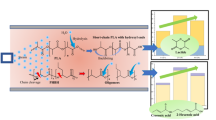Abstract
Thermal degradation of nitrogen (N)-containing recycled plastics (styrene-acrylonitrile (SAN), acrylonitrilebutadiene-styrene (ABS)) was carried out in a stirred-batch reactor at 300–400 ‡C under nitrogen stream. The degradation oil began to be generated over 300 ‡C. Recycled SAN plastic was converted to oil with 91.3 wt% yield at 380 ‡C, while only 70.9 wt% of recycled ABS plastics was converted to oil at the same temperature and both oils contained about the same 3.7 wt% nitrogen as an elemental basis. Rate of oil formation from the thermal degradation of SAN was much higher than that of ABS, but showed a similar degradation pattern in terms of chemical composition. In oil products, aromatic contents obtained at 360 ‡C were 70 wt% for SAN and 79 wt% for ABS, respectively, and decreased to 59 wt% and 57 wt% at 380 ‡C with increasing degradation temperature. Dominant product of both degradation oils was styrene, and the following was ethylbenzene for ABS, but none in case of SAN. Both oils contained the N-containing plastic additives that give rise to a confusion for the identification of authentic N-containing degradation products.
Similar content being viewed by others
References
Barman, B. N., “Behavioral differences between group I and group II base oils during thermo-oxidative degradation,”Tribology International,35, 15 (2002).
Brebu, M., Uddin, M. A., Muto, A., Sakata, Y. and Vasile, C., “The role of temperature program and catalytic system on the quality of acrylonitrile-butadiene-styrene degradation oil,”J. Anal. Appl. Pyrol.,63, 43 (2002).
Ciliz, N. K., Ekinci, E. and Snape, C. E., “Pyrolysis of virgin and waste polypropylene and its mixtures with waste polyethylene and polystyrene,”Waste Management,24, 173 (2004).
Day, M., Cooney, J. D., Touchette-Barrette, C. and Sheehan, S. E., “Pyrolysis of mixed plastics used in the electronic industry,”J. Anal. Appl. Pyrol.,63, 43 (2002).
Dong, D., Tasaka, S., Aikawa, S., Kamiya, S., Inagaki, N. and Inoue, Y., “Thermal degradation of acrylonitrile-butadiene-styrene terpolymer in bean oil,”Polym. Degrad. Stab.,73, 319 (2001).
Lee, K.-H., Noh, N.-S., Shin, D.-H. and Seo, Y.-H., “Comparison of plastic types for catalytic degradation of waste plastics into liquid products with spent FCC catalyst,”Polym. Degrad. Stab.,78, 539 (2002).
Lee, K.-H., Shin, D.-H. and Seo, Y.-H., “Liquid-phase catalytic degradation of mixtures of waste high-density polyethylene and polystyrene over spent FCC catalyst. Effect of mixing proportions of reactants,”Polym. Degrad. Stab.,84, 123 (2004).
Miskolczi, N., Bartha, L., Deak, G. and Jover, B., “Thermal degradation of municipal plastic waste for production of fuel-like hydrocarbons,”Polym. Degrad. Stab.,86, 357 (2004).
Oh, S. C., Lee, H. P., Kim, H. T. and Yoo, K. O., “Kinetics of nonisothermal thermal degradation of styrene-butadiene rubber,”Korean J. Chem. Eng.,16, 543 (1999).
Seo, Y.-H. and Shin, D.-H., “Determination of paraffin and aromatic hydrocarbon type chemicals in liquid distillates produced from the pyrolysis process of waste plastics by isotope-dilution mass spectrometry,”Fuel,81, 2103 (2002).
Suzuki, M. and Wilkie, C. A., “The thermal degradation of acrylonitrile-butadiene-styrene terpolymer as studied by TGA/FTIR,”Polym. Degrad. Stab.,47, 217 (1995).
Swasey, C. C.,Antioxidants, in Plastics Additives and Modifiers Handbook edited by Jesse Edenbaum, Van Nostrand Reinhold, 115, 15th Av., New York, NY 100003, USA, p. 193–202 (1992).
Tiganis, B. E., Burn, L. S., Davis, P. and Hill, A. J., “Thermal degradation of acrylonitrile-butadiene-styrene (ABS) blends,”Polym. Degrad. Stab.,76, 425 (2002).
van Grieken, R., Serrano, D. P., Aguado, J., Garcia, R. and Rojo, C., “Thermal and catalytic cracking of polyethylene under mild conditions,”J. Anal. Appl. Pyrol.,58–59, 127 (2001).
Williams, P. T. and Williams, E. A., “Fluidised bed pyrolysis of low density polyethylene to produce petrochemical feedstock,”J. Anal. Appl. Pyrol.,51, 107 (1999).
Yang, S., Castilleja, J. R., Barrera, E. V. and Lozano, K., “Thermal analysis of an acrylonitrile-butadiene-styrene/SWNT composite,”Polym. Degrad. Stab.,83, 383 (2004).
Author information
Authors and Affiliations
Corresponding author
Rights and permissions
About this article
Cite this article
Lee, KH., Shin, DH. & Seo, YH. Thermal degradation of nitrogen-containing polymers, acrylonitrile-butadiene-styrene and styrene-acrylonitrile. Korean J. Chem. Eng. 23, 224–229 (2006). https://doi.org/10.1007/BF02705720
Received:
Accepted:
Issue Date:
DOI: https://doi.org/10.1007/BF02705720




